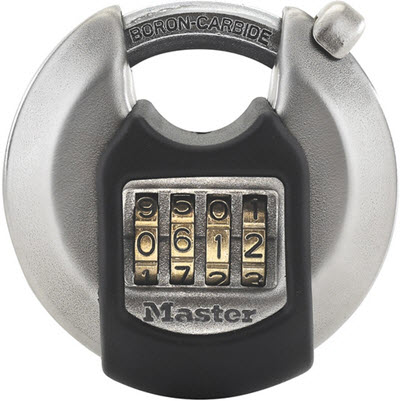Combination padlock
Contents

Many schools opt for combination padlocks for the lockers instead of key-operated padlocks, since keys can easily be stolen, misplaced or simply forgotten at home in the morning. If your kid will be keeping his or her stuff in a locker this school year, you can expect the school supply list to include a request for a combination padlock of a certain size. Make sure you follow the size range requirement because otherwise, the shackle might be too thick to get through or too small to be able to close.
The exact design of school lockers intended for use with a padlock vary. One common configuration is the hasp and staple, where a hinged metallic strap (the hasp) fits over a metallic loop (the staple). You close the locker door, push the hasp so that the staple goes through it, and then push the shackle of an open padlock through the staple. Lock the padlock to prevent others from pushing the staple back through the hasp and open the locker.
What is a padlock?
A padlock is a type of portable lock consisting of three main components: body, shackle and locking mechanism. The typical shackle for a padlock is a U-shaped loop of metal.
Swing styles
Most padlocks shackles either swing away or slide out of the padlock body when in the unlocked position. Older padlocks are almost always the swing-style padlocks.
Locking mechanisms
The two most commonly occurring locking mechanisms for padlocks are integrated and modular.
Integrated
 This type of locking mechanism directly engages the padlock’s shackle with the tumblers.
This type of locking mechanism directly engages the padlock’s shackle with the tumblers.
A majority of these padlocks require a key not just for unlocking, but for locking as well. Simply pushing down the shackle to lock the padlock will not work.
Padlocks with an integrated locking mechanism are typically designed in a way that makes it difficult/impossible to take the padlock apart and then put it together again, e.g. for servicing it or to change the tumblers.
Modular
Compared to the integrated locking mechanism, the modular locking mechanism for padlocks is a fairly recent invention. With a modular style, the locking mechanism does not directly engage the padlock’s shackle with the tumblers. Instead, there will be a plug within the cylinder that turns to allow the so-called “locking dog” to retract from notches cut into the shackle.
Modular locking mechanisms usually employ pin, wafer and disc tumblers. Also, most of these padlocks can be locked by simply pushing down the shackles – the key is only required to open the lock.
Padlocks with a modular locking mechanism can usually be taken apart and then put back together again, e.g. to change the tumblers or service the lock.
What is a combination padlock?
Instead of requiring a key to unlock, a combination padlock requires a correct code to be entered. For most combination padlocks used in schools, you enter the code by moving three reels, where each reel is numbered from 0 to 9, making one thousand different permutations possible.
An alternative option is the combination lock with a single dial that interacts with several parallel discs. With a single dial, it is easier to fit in many numerals, e.g. 0-60 or 0-100. Customarily, this style of lock is opened by rotating the dial clockwise to the first numeral, counterclockwise to the second numeral, and so on, until all numerals have been entered in the right order.
Cheap combination padlocks are usually not very safe since many of them can be opened by listening carefully to the clicking sound made as the correct number slides into place.
Combination padlock with key
Some combination padlocks come with a key, giving the user the option to use a key instead of a combination to open the lock.
Letters instead of numbers
Some combination padlocks have letters instead of numbers on their reels. This type of padlocks will usually have at least four reels, and five reels are also common. This allows the user to pick a four-letter or five-letter word combination as their password for the lock.
For many users, remembering a letter combination is easier than a number combination.
Please note that letter padlocks usually don’t have the whole English alphabet on each reel, especially not on small padlocks of the type common in schools. Expect to get ten letters or so per reel. Some locks have nine letters + a blank spot on the fifth reel to allow for four-letter combinations.
The most well-known manufacturer is Wordlock Inc.